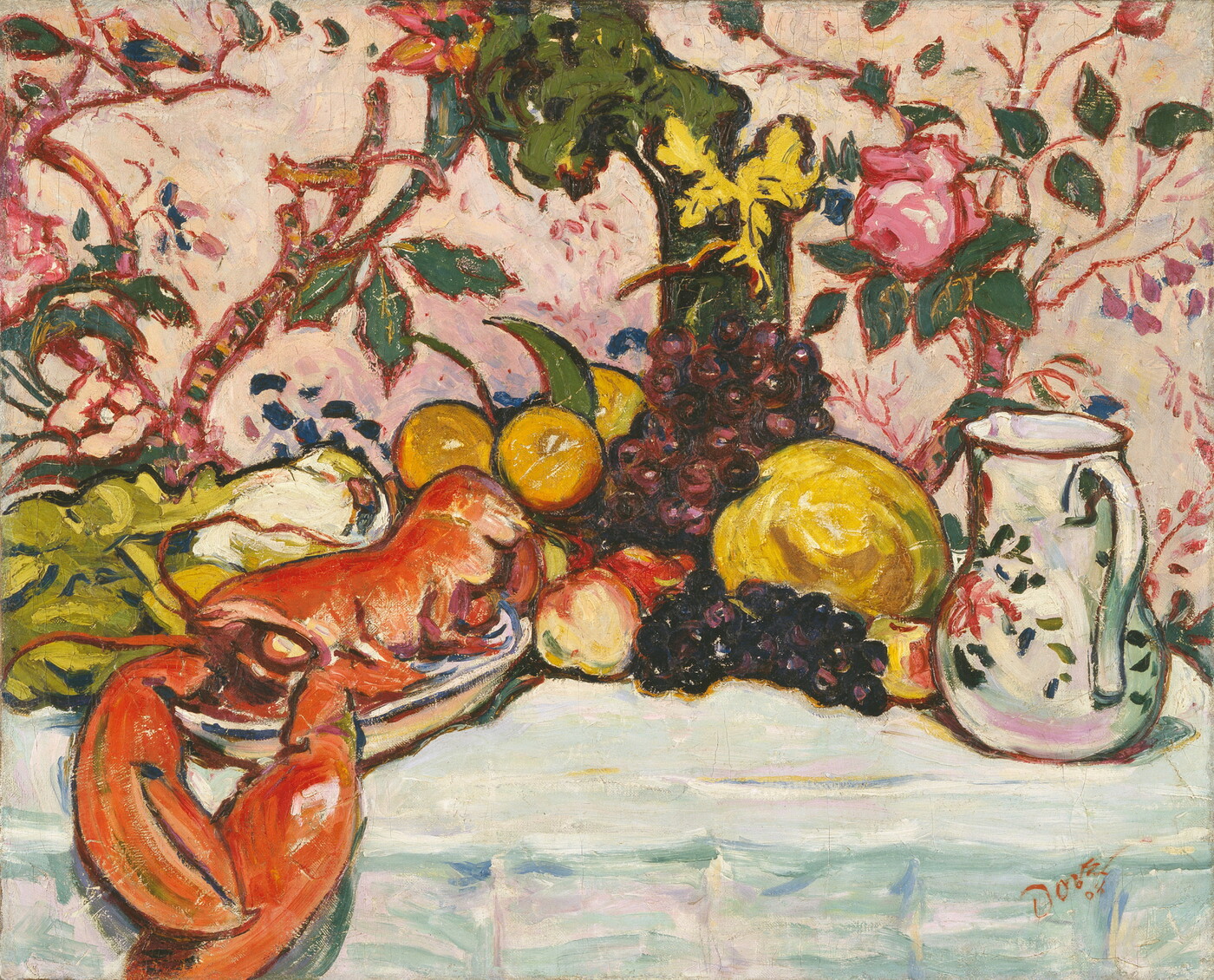

Artwork Image
Photo:
Controls
The Lobster
Object Details
-
Date
1908
-
Object Type
Paintings
-
Medium
Oil on canvas
-
Dimensions
25 5/8 x 32 in.
-
Inscriptions
Recto:
signed and dated, l.r.: DOVE \ 08
-
Credit Line
Amon Carter Museum of American Art, Fort Worth, Texas, Acquisition in memory of Anne Burnett Tandy, Trustee, Amon Carter Museum of American Art, 1968-1980
-
Accession Number
1980.29
-
Copyright
Public domain
Object Description
In 1907, Dove gave up his job as a commercial illustrator to study modern art in France. There, he was inspired by the still-life paintings of Paul Cézanne and Henri Matisse. Cézanne experimented with spatial dimensions by layering objects on uneven tabletops, while Matisse used pure color and decorative designs to explore rhythmic energy.
Like those French masters, Dove stacked ripe fruits and a lobster on a cloth-covered table set against busy wallpaper. The backdrop, placement of the objects, and palette of bright pinks, oranges, and violets combine to infuse this static subject with a visual liveliness. While critics disparaged the painting, Dove was undeterred and went on to become one of America’s first abstract artists.
-
American Still LifeFebruary 14–August 16, 2015
Organized in celebration of a recent acquisition, American Still Life highlights the ability of 19th and 20th-century American artists to celebrate the ordinary through their paintings, whether trompe l’oeil masters or modernist photographers.
-
From Remington to O’Keeffe: The Carter’s Greatest HitsOctober 6, 2018–March 22, 2019
During the renovation, this exhibition features highlights from the permanent collection, including paintings, photographs, and sculptures, by some of America’s most renowned artists.
Additional details
Location: On view
See more by Arthur Dove
Tags
Video:
Video:
-
This early 20th-century artist was considered progressive when he painted this still life called The Lobster.
This scene shows a table with a white tablecloth draped over it with several food items placed on top. The table is cropped so only the top and a few inches of the front side are shown; the legs and ends of the table are not seen. The background wallpaper is a soft pink and green floral motif. The focal point on the table is a red lobster on a platter placed toward the left side of the canvas. The giant claws hang over the front side of the table, and the very tip of the claw falls on the right off the edge of the canvas. To the left of the lobster is a yellow and green head of lettuce. On the right side of the crustacean are oranges, heart-shaped yellow peaches, and a large bunch of dark purple grapes. There is a giant yellow mango on the right side of the table, sitting next to a white pitcher. The handle of the pitcher is facing out toward the viewer, and pink dashes make a flower shape with green dashes as leaves on the bulbous body of the pitcher.
The artist signed his last name, “Dove,” in the bottom right corner.
-
What is the significance of the genre of still life in the history of painting? How have still lifes changed over time?
What can the objects chosen for a still life tell us about the artist, patron, or time in which they were created?
What impact does medium have on the final work of art?
How might public response shape the development of an artist or the development of artistic styles and movements?
-
All Levels
Activity 1
The artist painted The Lobster over 100 years ago. Imagine a table full of food today. Students will make a sketch of a modern table scene in the style of Dove. Students should consider: What food and objects are on the table? How are they arranged? What is in the background?Activity 2
Show an image of Raphaelle Peale’s Peaches and Grapes in a Chinese Basket from almost 100 years earlier. Have students compare and contrast the two artworks. Set up a still life in the classroom (a tablecloth and plastic oranges, lobster, grapes) for students to draw. Ask them to think about their choices as they work: Are they choosing realistic colors or less expected ones? Adding straight lines or seeking rounded shapes? Is their setting flat or deep?
Share Educator Resources
Amon Carter Disclaimer
This information is published from the Carter's collection database. Updates and additions based on research and imaging activities are ongoing. The images, titles, and inscriptions are products of their time and are presented here as documentation, not as a reflection of the Carter’s values. If you have corrections or additional information about this object please email us to help us improve our records.
Every effort has been made to accurately determine the rights status of works and their images. Please email us if you have further information on the rights status of a work contrary or in addition to the information in our records.
Related Works
-
The Time Game, 2011
Jane Hammond
Gelatin silver print
P2011.29
-
Zerogram, 2017
Ellen Carey
Dye coupler print
P2018.40
-
Untitled (Pittsburgh Housing), 1930s
Manuel de Aumente
Gelatin silver print
P2009.11
-
Untitled, 1970
Luchita Hurtado
Lithograph
1970.86
-
Green Nude, ca. 1918-1924
Gaston Lachaise
Crayon on paper
2018.4
-
A Closet Door, 1904-1906
John Frederick Peto
Oil on canvas
1983.158
-
Drawing No. 18, 1919
Georgia O'Keeffe
Charcoal on paper
1997.2
-
Untitled #52, 2002
Laura Letinsky
Dye coupler print
P2007.3
-
Egg Beater No. 2, 1928
Stuart Davis
Oil on canvas
1996.9
